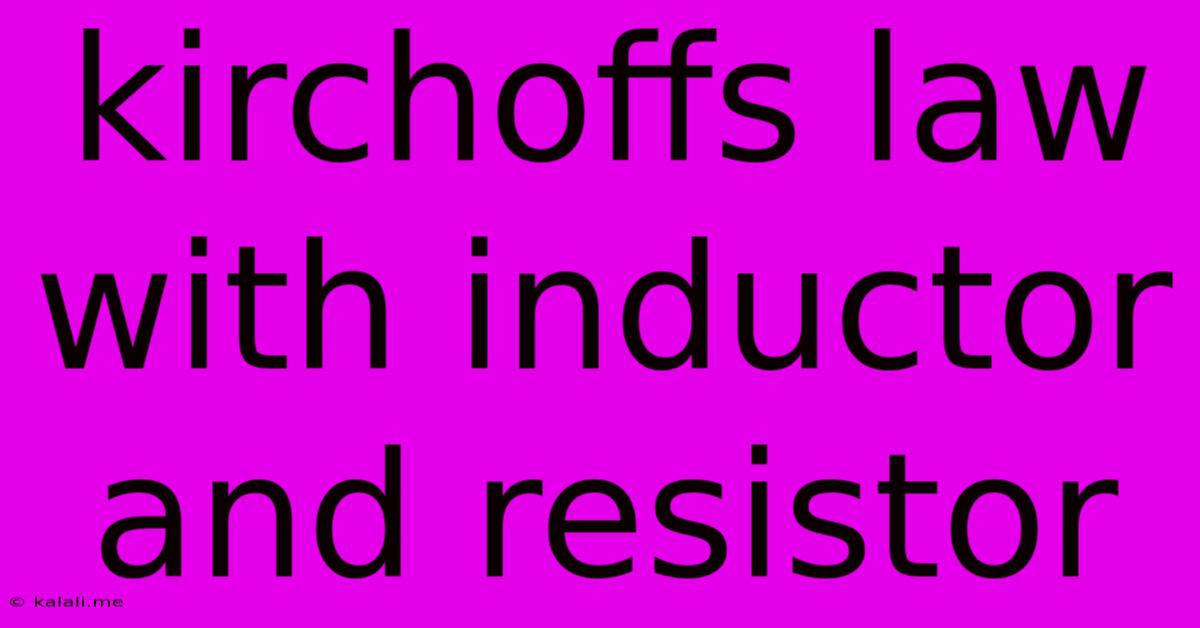Kirchoffs Law With Inductor And Resistor
Kalali
May 24, 2025 · 4 min read

Table of Contents
Kirchhoff's Law with Inductors and Resistors: A Comprehensive Guide
Meta Description: Understanding Kirchhoff's laws in circuits containing inductors and resistors is crucial for electrical engineering. This guide provides a comprehensive explanation, covering both Kirchhoff's voltage and current laws with practical examples and clear illustrations. Learn about the impact of inductance on circuit behavior and master the analysis of RL circuits.
Kirchhoff's laws are fundamental principles in circuit analysis, providing a systematic approach to solving complex electrical networks. While often introduced with simpler resistor-only circuits, understanding their application with inductors is crucial for analyzing more realistic scenarios, particularly in circuits involving transient responses and inductive components like motors, transformers, and solenoids. This guide delves into the application of Kirchhoff's laws in circuits containing both resistors (R) and inductors (L), often referred to as RL circuits.
Kirchhoff's Voltage Law (KVL) in RL Circuits
Kirchhoff's Voltage Law states that the sum of the voltages around any closed loop in a circuit is zero. In an RL circuit, this means the voltage across the resistor (VR) and the voltage across the inductor (VL) must sum to zero, considering the source voltage (Vs). Mathematically:
Vs - VR - VL = 0
Where:
- Vs: The source voltage (often a battery or power supply).
- VR: The voltage across the resistor (given by Ohm's Law: VR = IR, where I is the current).
- VL: The voltage across the inductor (given by: VL = L(dI/dt), where L is the inductance and dI/dt is the rate of change of current).
The inclusion of the inductor introduces a time-dependent element. Unlike a resistor, the voltage across an inductor isn't simply proportional to the current; it's proportional to the rate of change of the current. This means the circuit's behavior is dynamic and changes over time.
Kirchhoff's Current Law (KCL) in RL Circuits
Kirchhoff's Current Law states that the sum of currents entering a node (junction) in a circuit is equal to the sum of currents leaving that node. In simpler RL circuits, this law is often straightforward. The same current flows through both the resistor and the inductor because they are connected in series. However, in more complex circuits with parallel branches containing inductors and resistors, KCL becomes essential for analyzing current distribution at each node.
Solving RL Circuits Using Kirchhoff's Laws
Solving RL circuits involves applying KVL and solving the resulting differential equation. This often involves techniques like integrating factors or Laplace transforms for more complex circuits. Consider a simple series RL circuit:
A simple series RL circuit with a voltage source (Vs), a resistor (R), and an inductor (L). Applying KVL:
Vs = IR + L(dI/dt)
This is a first-order differential equation. The solution will give the current (I) as a function of time (t), revealing how the current builds up or decays in the circuit. The solution's form depends on whether the circuit is being charged (current increasing) or discharging (current decreasing).
Transient and Steady-State Responses in RL Circuits
RL circuits exhibit both transient and steady-state responses. The transient response is the initial, rapidly changing behavior of the current as the circuit reacts to a change in voltage. The steady-state response is the long-term behavior of the current after the transient effects have subsided. The time constant (τ = L/R) determines how quickly the transient response decays. A larger time constant means a slower response.
Understanding these responses is crucial for designing circuits with specific timing characteristics.
Practical Applications
The principles discussed here are fundamental to many electrical and electronic systems. Examples include:
- Motor Control: Inductors are integral parts of electric motors, and Kirchhoff's laws are essential for understanding and controlling their behavior.
- Power Supplies: Smoothing circuits in power supplies often utilize inductors to filter out unwanted voltage fluctuations.
- Switching Circuits: Understanding transient responses in RL circuits is crucial for designing efficient and reliable switching circuits.
By mastering the application of Kirchhoff's laws to RL circuits, you gain a deeper understanding of the dynamic behavior of electrical circuits and the importance of inductance in shaping circuit responses. This knowledge is essential for anyone working with electrical and electronic systems.
Latest Posts
Latest Posts
-
Draco Malfoy Bullying Hermione Prisoner Of Azkaban
May 24, 2025
-
Prevent Zooming In When Setting Android Wallpaper
May 24, 2025
-
Ansible Diff Module Example Between Two Files
May 24, 2025
-
Fastest Car In Gta 5 Story Mode
May 24, 2025
-
How Do You Discharge A Capacitor
May 24, 2025
Related Post
Thank you for visiting our website which covers about Kirchoffs Law With Inductor And Resistor . We hope the information provided has been useful to you. Feel free to contact us if you have any questions or need further assistance. See you next time and don't miss to bookmark.